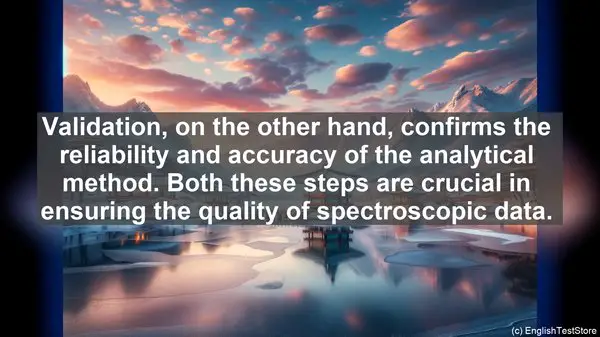Introduction to Spectroscopy
Welcome to today’s lesson on spectroscopy. As you delve deeper into this fascinating field, you’ll encounter numerous terms that may seem similar but have distinct meanings. In this lesson, we’ll focus on the top 10 commonly confused words in spectroscopy. By the end, you’ll have a clearer understanding of these terms and be able to use them confidently in your studies.
1. Absorption vs. Emission
Absorption and emission are two fundamental processes in spectroscopy. While absorption refers to the absorption of light by a substance, emission is the release of light by a substance. Think of absorption as ‘taking in’ and emission as ‘giving out.’ Understanding the difference between these terms is crucial in interpreting spectroscopic data accurately.
2. Wavelength vs. Frequency
Wavelength and frequency are key properties of light waves. Wavelength refers to the distance between two consecutive peaks or troughs of a wave, while frequency is the number of wave cycles passing a point in a given time. In spectroscopy, both these properties play a significant role in determining the behavior of light and its interaction with matter.
3. Fluorescence vs. Phosphorescence
Fluorescence and phosphorescence are types of light emission. Fluorescence is the almost instantaneous emission of light upon light absorption, while phosphorescence involves a delayed emission. You can think of fluorescence as a ‘quick flash’ and phosphorescence as a ‘lingering glow.’ This distinction is vital in various applications, such as organic LED technology and biological imaging.
4. Excitation vs. Ionization
Excitation and ionization are processes that involve the energy levels of atoms or molecules. Excitation refers to the promotion of an electron to a higher energy level, while ionization involves the complete removal of an electron, resulting in the formation of an ion. Both these processes have unique effects on the properties and behavior of the substance being studied.

5. Ground State vs. Excited State
The ground state is the lowest energy level of an atom or molecule, while the excited state is any energy level above the ground state. When an electron absorbs energy, it transitions from the ground state to an excited state. This energy can later be released, leading to various spectroscopic phenomena. Understanding the concept of energy levels is crucial in spectroscopic analysis.
6. Transmittance vs. Reflectance
Transmittance and reflectance are terms used to describe the behavior of light when it encounters a substance. Transmittance refers to the ability of a substance to allow light to pass through it, while reflectance is the ability to bounce back light. These properties are essential in various spectroscopic techniques, such as UV-Vis and IR spectroscopy.
7. Monochromatic vs. Polychromatic
Monochromatic light consists of a single wavelength or color, while polychromatic light contains multiple wavelengths. In spectroscopy, the choice between monochromatic and polychromatic light depends on the specific analysis requirements. For instance, monochromatic light is often preferred for its higher precision in certain experiments.
8. Intensity vs. Irradiance
Intensity and irradiance are terms used to describe the power or energy of light. Intensity refers to the total power of light, while irradiance is the power per unit area. These terms are crucial in understanding the amount of light being used in a spectroscopic experiment and its effect on the sample being analyzed.
9. Spectral Range vs. Bandwidth
Spectral range and bandwidth are terms used to describe the range of wavelengths or frequencies of light. Spectral range refers to the entire range covered, while bandwidth is the width of a specific range. These terms are often encountered when selecting the appropriate spectroscopic instrument for a particular analysis.
10. Calibration vs. Validation
Calibration and validation are essential steps in spectroscopic analysis. Calibration involves the process of establishing a relationship between the measured signal and the analyte concentration. Validation, on the other hand, confirms the reliability and accuracy of the analytical method. Both these steps are crucial in ensuring the quality of spectroscopic data.

